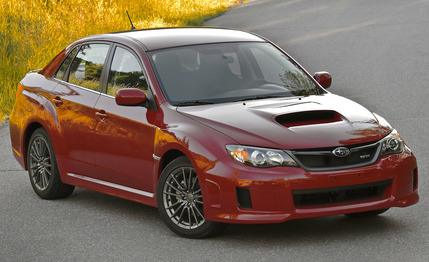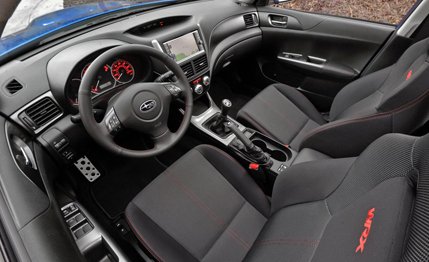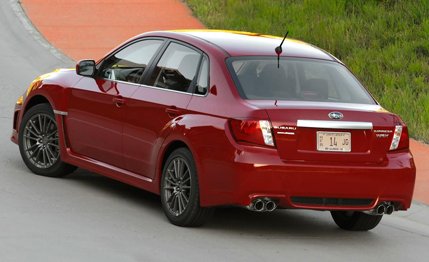 Short Take Road Test
Short Take Road Test

In the years since its 2002 U.S. introduction, the rally-inspired Subaru Impreza WRX evolved aesthetically like Barry Bonds, morphing from the scrawny-looking yet scrappy original to this version, the beefed-up and muscular 2011 model. Yes, there were a few stylistic missteps along the way, 2006’s funky nose and the softer look of the 2008 chief among them, but we’ve never loved the WRX for its looks. This vehicle has always been a blast to drive, and it got even better for 2009 when Subaru poured on 41 more hp, for a total of 265, and stirred in a raft of chassis revisions. The result was a 0-to-60-mph run of 4.7 seconds and more poise than ever; the only remaining issues were a tendency to understeer and styling too much like a regular Impreza’s. You may now consider these concerns rectified.
Updated Inside, Out, and Underneath
This year, the WRX sedan and hatchback receive the aggressive, wide-body design of the more powerful STI, including its quad-tipped exhaust. Track increases of 1.3 inches in front and 1.5 inches in the rear—coming in part from the lighter, wider 17-inch wheels (eight inches wide versus seven)—ensure that the newly flared fenders are filled. As expected given the wheel widening, the Dunlop SP Sport 01 skins increase in width from 225 millimeters to 235. The chassis changes are rounded out by stiffer rear subframe bushings.

Inside, new carbon-colored trim accents the top of the dash. We like the color, but among the dash, center stack, and console, there are three different silver/gray hues, which together look a bit chintzy. A revised audio system includes Bluetooth and iPod connectivity as standard; it’s the only other major interior change for 2011.

Now with More Fun!
The small alterations to the footprint improve the WRX’s ride and handling as much as the burlier styling enhances its look. Previously, the WRX pushed when approaching the limit—although a four-wheel drift was (and is) always a throttle-lift away—but the newly widened stance has made it absolutely neutral. It’s not apparent in the test data (skidpad grip was up a touch to 0.89 g from the 0.87 g posted by the last WRX tested on these Dunlops), but toss the “Rex” into a corner and now neither front nor rear will let go without the other unless your inputs are overly aggressive. This composure at the limit vastly increases driver confidence, which is further enhanced by reduced body roll and steering that feels sharper and more responsive than the previous car’s. In short, the WRX finally feels at home on a track. As a bonus, getting there is more enjoyable, thanks to an incredibly refined ride.
Although we’d prefer better initial brake bite and a shifter that doesn’t feel so rubbery—a very good short-throw shifter is
available as an accessory—we can’t ask for much more than the punch delivered from the carry-over turbocharged 2.5-liter. The old-school, turbo-lagged initial delivery of its 265 hp and 244 lb-ft of torque isn’t exactly linear, but the shove and the wild flat-four bellow above 4000 rpm are quite exhilarating. This test car reached 60 mph in five seconds flat and covered the quarter-mile in 13.7 at 100 mph. Although the former number doesn’t match the 4.7-second pace of the 2009 model, it’s in the same neighborhood, and we’d be more than happy to trade a little straight-line performance for the improved handling.
A True Performance Bargain
A base WRX sedan starts at $26,220—$530 more than in 2010—and the car tested here came equipped with the Premium package ($2500) and navigation ($2000) for an as-tested price of $30,720. The Premium package adds fog lights, a sunroof, a rear spoiler, and heating elements for the front seats, mirrors, and windshield-wiper rest. If it were our coin, we’d skip the pricey extras and just add the short-throw shifter for $355.
The WRX has changed quite a bit in the years since its introduction, and the 2011 enhancements have produced the greatest-driving iteration yet. Perhaps best of all, it remains among the few standout enthusiast machines available for less than $30,000, proving that when a car makes big strides, the sticker price doesn’t have to follow suit.
